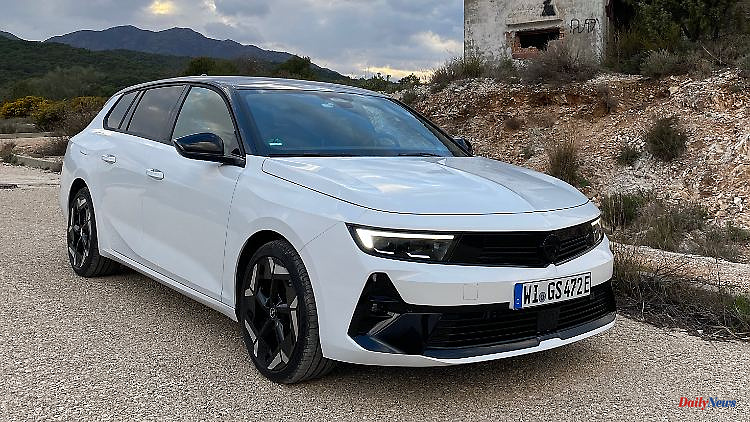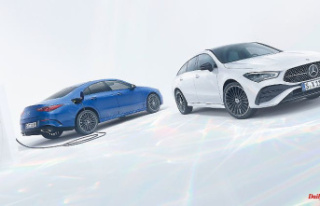Opel got the "GS" label out of the dustbin and didn't just miss it on the Astra. Tradition is trumps, the Rüsselsheim company had glorious times with Commodore GS/E, Monza GSE, but also Kadett GSI. In which footsteps is the Astra GSe following?
It was somehow clear that the "GSe" badge would be seen again on the boot lids of various Opel models. At least since the Manta GSe ElektroMod (the Manta A converted to electric drive by a small Opel engineering team) everyone was hot for the historical designation. Technicians, marketing people and the fan scene too, of course. And the buyers of the Opel Astra GSe, which costs at least 45,510 euros (but now stands for the electrical component and no longer for "injection"), should be a bit of a fan, because nobody really needs performance values beyond the 200 hp mark.
The company car tax, which may play a role for some potential customers, is certainly tempting. Because private trips that are taxed at a flat rate are paid for with the GSe on the basis of half the gross list price - but that's also possible with the weaker plug-in variant (180 hp system output), which is now also available as "GS", i.e. without "e". . But also simply as "Elegance".
So maybe fans, who primarily notice a powerful, specific front spoiler plus the rather delicately indicated diffuser as a conclusion below the bumper - Opel definitely doesn't want to be too thick. And so GSe-specific 18-inchers with a sporty design and black finish come across as quite flashy, but appear more cool than offensive. And the fact that the GSe is ten millimeters lower than the other variants and has a generally firmer set-up (including power steering) cannot be blamed, after all, that's how this version was created.
However, it does not reach the sharpness of the former OPC models, which is actually a shame. After all, the technology for a shovel more steam exists in the group, the hybrid line would also give 300 hp, at least the version with two electric machines. But technically it doesn't work, as developer Christian Hartweg explains. The compact Astra simply offers too little space and the wrong axle layout to implement the second electric motor at the rear. Okay, maybe many fans will have their say and Opel can soften to construct again.
Now we have to work with what we already have. And there is only one silent machine with a powerful 110 hp. In addition, there is an efficient, 1.6-liter four-cylinder petrol engine that delivers a respectable 180 hp in the drive cocktail. An eight-speed automatic with planetary gear bundles the power to a total of 225 hp and 360 Newton meters of torque - by no means poor, but clearly below the 280 horses with which an Astra OPC burns lines in the asphalt. Sorry, Opel, the thought resonates with you. Of course, the GSe is not an OPC either, but it would be so nice.
But whining doesn't help, no matter what level. And the level is high, especially since the Astra GSe - pragmatically oriented people can even get a station wagon for a moderate four-digit surcharge - with a factory-specified standard sprint (0 to 100 km/h) of 7.5 seconds is not a very slow car. However, not a really fast one either, although it trumps the first Kadett GSI 16V (150 hp) by at least 18 km/h at 235 km/h. Even the acceleration of the original GSI, which feels incredibly snappy, is eight seconds to 100 km/h slower for me, so you can see what insulation is all about. Quiet cars just seem more phlegmatic.
Paper values are one thing, practical experience another. It is still true that the Astra is a fine tourer - the 18-inch wheels, which burden the chassis with hard work, don't change that much. The oversized compact (4.64 meters long) in a tracksuit absorbs the pronounced waves of moderately accurately tarred southern Spanish roads properly. This may also be due to the so-called frequency-selective damping, which uses two oil circuits and uses either the small or the large flow rate depending on the excitation. This expands the range between a comfortable layout and a sporty pace.
But what about the drive? The GSe moves really confidently in the partial load range. Here the powerful e-machine pays into the drive account. If you shoo the Astra over the track with a lead foot, it seems a bit strained. Because the main drive source is then the small-volume petrol engine, and when using the entire speed range, even in sport mode (here the sound is modeled), it sounds a bit too thin - at least to arouse emotions that would actually be appropriate for the "GS" label. Honestly, the larger strand would have to come here. But hey, the now-adult Astra is more on the touring side of the Monza GSE and less on the side of sharp hot-hatches like the first Kadett GSI was. Who knows, maybe a sharp Corsa will come around the corner at some point, after all, Opel is also planning a lot of purely electric GSe models.
After all, if you let the currently most powerful Astra run on the country road and force it into understeering, you will be held in the center by comfortable but equally distinctive "GSe performance seats". The quotation from the price list is exciting simply because this ingredient is available free of charge. And because this furniture is not only electrically adjustable in many ways, but is also covered with body-friendly and stylish Alcantara upholstery. Anyway, it's fun to sit here longer.
Even if the first laps with the latest Astra derivative don't even measure 100 kilometers, the thought of sending the Rüsselsheimer on the long haul is pleasant. On the other hand, if you are traveling short distances, you can move the 1.8-tonner around 60 kilometers purely electrically thanks to the twelve kWh battery capacity. The charging time to completely fill the battery is two hours, as long as the charging power is 7.4 kW. Of course, you have to have the appropriate charging options, which is a prerequisite for using a plug-in hybrid appropriately. But potential customers know that too.
Finally, a quick look at the infotainment. Of course, the fresh Opel is not stingy with screen space and even offers a head-up display for an additional charge of 800 euros, which projects its information into the windscreen instead of into a Plexiglas pane in front of it. It simply looks more valuable and fits the solid workmanship of the new Astra. You can quickly grasp the many menus on the monitor, but you are still happy that fortunately some physical buttons are available. Everyday things like operating the air conditioning can be done in this way without having to use the monitor.
You don't have to struggle if the Astra (this applies above all to the station wagon) has to really tow. Almost 1600 liters of luggage space is a big word and also an announcement to the competition. By the way, a Kadett GSI would have to fit here. It's great that performance and practicality can be combined today. And with a dash of comfort on top.












